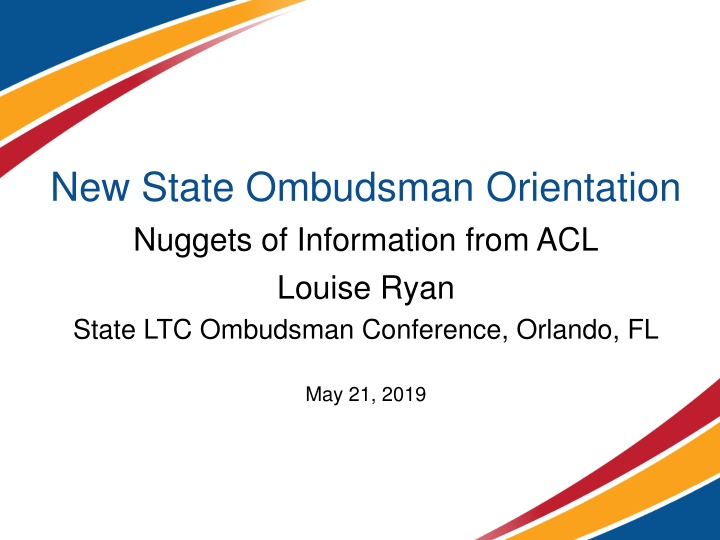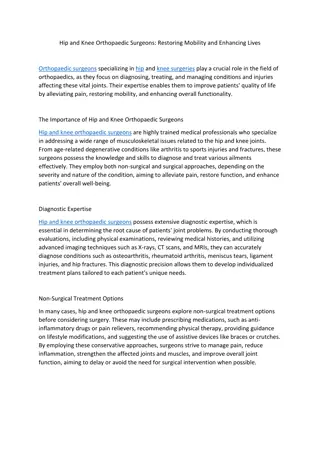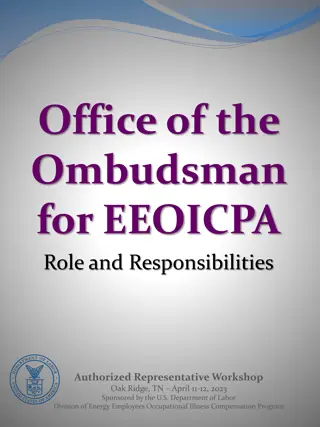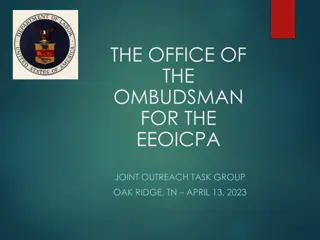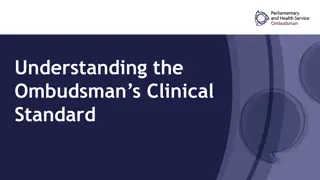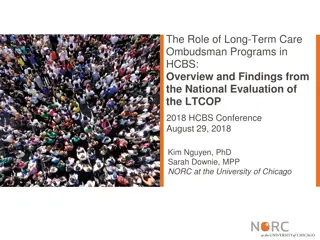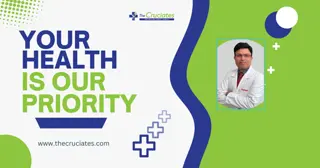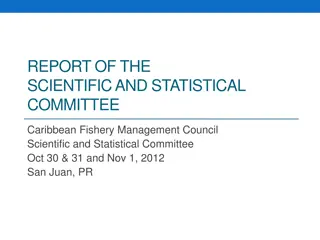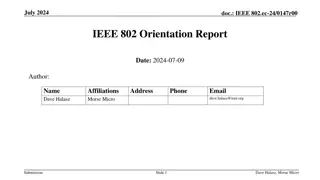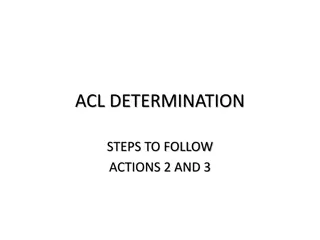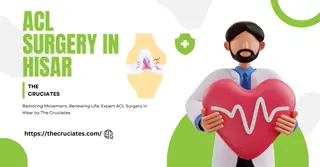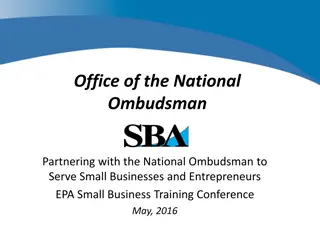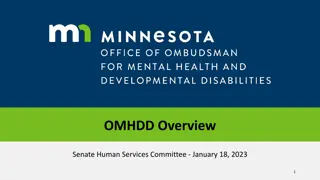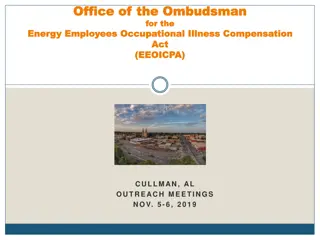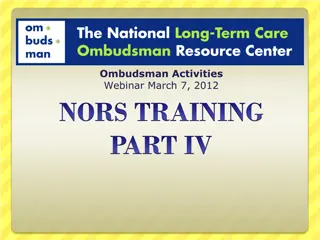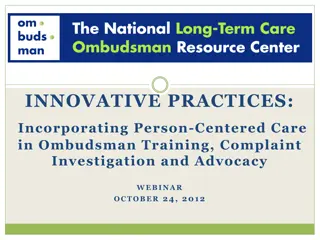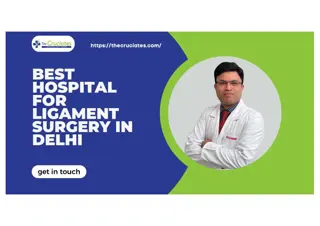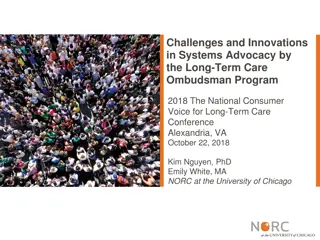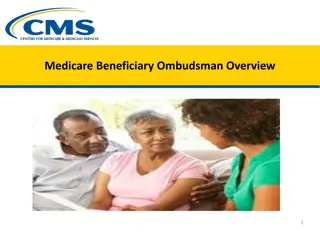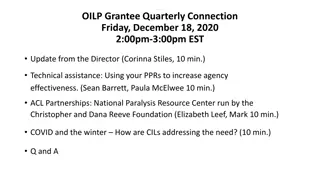Overview of ACL: New State Ombudsman Orientation Insights
Explore insights from the ACL Louise Ryan State LTC Ombudsman Conference, covering NORS basics, administration details, ACL mission, leadership, and tips on effectively using the National Ombudsman Reporting System (NORS) for data collection and reporting.
Download Presentation

Please find below an Image/Link to download the presentation.
The content on the website is provided AS IS for your information and personal use only. It may not be sold, licensed, or shared on other websites without obtaining consent from the author.If you encounter any issues during the download, it is possible that the publisher has removed the file from their server.
You are allowed to download the files provided on this website for personal or commercial use, subject to the condition that they are used lawfully. All files are the property of their respective owners.
The content on the website is provided AS IS for your information and personal use only. It may not be sold, licensed, or shared on other websites without obtaining consent from the author.
E N D
Presentation Transcript
New State Ombudsman Orientation Nuggets of Information from ACL Louise Ryan State LTC Ombudsman Conference, Orlando, FL May 21, 2019
Welcome Quick Overview of ACL NORS basics and uses Ombudsman program rule Collaboration with other agencies & Memorandums of Understanding Question & Answer 2
Administration for Community Living An operating division within the Department of Health and Human Services formed in April 2012 Administration on Aging (administers the Older Americans Act) Administration on Disabilities, which includes the Administration on Intellectual and Developmental Disabilities (DD), Includes: the DD Councils Protection & Advocacy Systems Centers for Independent Living State Health Insurance Assistance Programs (SHIP) National Institute on Disability and Independent Living Rehabilitation Research (NIDILRR) Programs
ACL Mission Maximize the independence, well-being, and health of older adults, people with disabilities across the lifespan, and their families and caregivers.
ACL Leadership Lance Robertson: Assistant Secretary for Aging and Administrator, Administration for Community Living Mary Lazare: Principal Deputy Administrator Edwin Walker: Deputy Assistant Secretary for Aging of the Administration on Aging (AoA)
NORS National Ombudsman Reporting System (NORS) Only data collection that describes the experiences of residents Essential that your program have regimented practices to: Collect and enter data Review for quality (monthly is ideal) Use your program s data to inform the public, policy makers and other entites. 6
NORS Getting lost in the weeds of NORS Don t get stuck in the what if s Focus on consistent and routine data entry Hold routine meetings to discuss coding and to review NORS training Run monthly reports Expect at a minimum quarterly reports 7
Admission, Transfer, Discharge, Eviction Admission, Transfer, Discharge Chart 2013-2017 22. Room assignment/room change/interfaculty transfer 21. Discrimination in admission due to Medicaid status 20. Discrimination in admission due to condition, disability 19. Discharge/eviction - planning, notice, procedure, implementation, inc. abandonment 18. Bed hold - written notice, refusal to admit 17. Appeal Process - absent, not followed 16. Admission contract and/or procedure 0 2,000 4,000 6,000 8,000 10,000 12,000 14,000 16,000 2017 2016 2015 2014 2013 8
Individual advocacy The Ombudsman program was able to assist a resident to contest an eviction notice. The resident is living with Alzheimer s disease and the facility was not providing the individualized care that she needed. The persistence of the volunteer was instrumental in obtaining the needed staffing changes, ensuring shower safety, lowering the dosage of medications which caused sleepiness, and providing assistance at meal times. Her (volunteer) advocacy helped the resident and made a positive impact for all resident s living in this facility 9
How to tell your states story Have a story Include a picture Share the data If advocating to address a problem, have a solution 10
Not documenting = Silencing the Problems The fact that ombudsmen have a more frequent presence in facilities and are authorized to take and record complaints, and advocate for residents, means that their work is essential. When they are not there to handle problems, those problems are likely to persist unabated. When problems are not recorded, there is not even a public record that they happened. Worse than suffering in silence, the resident s suffering has been effectively silenced and there is no way for anyone to know what may be going on in a facility. Quote from report: The New York State Ombudsman Program: An Assessment of Current Performance, Issues and Obstacles. By: Richard J. Mollot, Executive Director, The Long Term Care Community Coalition.
Why Have a Rule? Over the years state Ombudsman reported frequent challenges with their ability to fulfill role as required by OAA: An independent problem-solver focused on individual resident interests Ability to perform effective system-level policy advocacy Ability to communicate to the general public and media Full-time position Designate individuals (and local entities) Relationship with local Ombudsman entities Confidentiality of Ombudsman information Access to adequate legal counsel The rule addresses many of those identified issues 13
Law, Regulation, Guidance Framework Older Americans Act Law Public Law 109-365 42 U.S. Code Chapter 35 45 CFR Part 1326 & 1328 (Title VI) 45 CFR Parts 1321 and 1324 Titles (III & VII) 45 CFR Part 1321 (Title III) Regulation Data Collection i.e. (NORS) Program Instructions Guidance Letters to states
LTC Ombudsman Programs Rule: Table of Contents 45 CFR 1324 1324.1 Definitions 1324.11 Establishment of the Office of the State Long- Term Care Ombudsman 1324.13 Functions and responsibilities of the State Long- Term Care Ombudsman 1324.15 State agency responsibilities related to the Ombudsman program 1324.17 Responsibilities of agencies hosting local Ombudsman entities 1324.19 Duties of the representatives of the Office 1324.21 Conflicts of interest 15
LTCOP Rule - MoU 1324.13 (h) Through adoption of memoranda of understanding and other means, the Ombudsman shall lead state-level coordination, and support appropriate local Ombudsman entity coordination, between the Ombudsman program and other entities with responsibilities relevant to the health, safety, well-being or rights of residents of long-term care facilities including, but not limited to: (1) Area agency on aging programs; (2) Aging and disability resource centers; (3) Adult protective services programs; 16
LTCOP Rule - MoU (4) Protection and advocacy systems, as designated by the State, and as established under the Developmental Disabilities Assistance and Bill of Rights Act of 2000 (42 U.S.C. 15001 et seq.); (5) Facility and long-term care provider licensure and certification programs; (6) The State Medicaid fraud control unit, as defined in section 1903(q) of the Social Security Act (42 U.S.C. 1396b(q)); (7) Victim assistance programs; (8) State and local law enforcement agencies; (9) Courts of competent jurisdiction; and (10) The State legal assistance developer and legal assistance programs, including those provided under section 306(a)(2)(C) of the Act. See Frequently Asked Questions: https://www.acl.gov/node/68 17
MoU Legal Assistance Older Americans Act Section 712(h)(8) Requires the Ombudsman to: coordinate, to the greatest extent possible, ombudsman services with legal assistance provided under section 306(a)(2)(C), through adoption of memoranda of understanding and other means; 18
The Why and the How Why- Experiences of long term care facility residents often present issues optimally addressed through collaborative efforts and/or warm handoffs Example Legal assistance and involuntary discharges Established relationships facilitate individual and systemic advocacy that both Long-Term care Ombudsman and legal assistance providers can effectively engage in Shared trainings and educational outreach can identify and possibly resolve issues before they become problems 19
How do Ombudsman programs access to legal support for residents? There are many ways that LTCOP s and legal services work together depending on a states organizational structure: Ombudsman programs and legal services are frequently in separate organizations and successful collaborations are supported through program policies and procedures that describe how to refer residents to legal services; Memoranda of understanding support these referral processes and working relationships; Programs that are co-located often develop formalized referral processes and protocols to keep ombudsman work and recordkeeping distinct from the legal services functions of the entity. 20
Benefits of Coordination Individual Residents: Strength of the LTC Ombudsman program is the on- going support for residents before, during, and after legal actions, ombudsmen are an important resource for and support to residents. Examples of Systems Collaboration: Strengthening state policy on financial exploitation; Long-term care consumer protections, i.e. increased protections from evictions in residential care settings; Participation on statewide task forces; i.e. WINGS; Elder Abuse Prevention workgroups, etc. 21
Discussion 22
